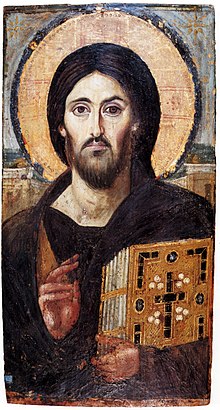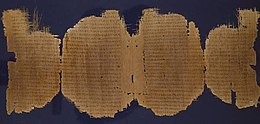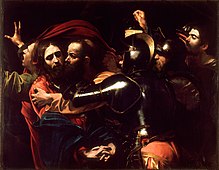|
Jesus
|
|
|---|---|

The Christ Pantocrator of Saint Catherine’s Monastery at Mount Sinai, 6th century AD
|
|
| Born | c. 6 to 4 BC[a] |
| Died | AD 30 or 33 (aged 33–38) |
| Cause of death | Crucifixion[b] |
| Known for | Central figure of Christianity |
| Parents | |
Virtually all modern scholars of antiquity agree that Jesus existed historically.[f] Accounts of Jesus’ life are contained in the Gospels, especially the four canonical Gospels in the New Testament. Academic research has yielded uncertainty on the historical reliability of the Gospels and how closely they reflect the historical Jesus.[18][g] Jesus was a Galilean Jew who was circumcised, was baptized by John the Baptist, began his own ministry,[10] and was often referred to as “rabbi“.[21] Jesus debated with fellow Jews on how to best follow God, engaged in healings, taught in parables, and gathered followers.[22][23] He was arrested in Jerusalem and tried by the Jewish authorities,[24] turned over to the Roman government, and crucified on the order of Pontius Pilate, the Roman prefect of Judea.[22] After his death, his followers believed he rose from the dead, and the community they formed eventually became the early Christian Church.[25] Accounts of his teachings and life were initially conserved by oral transmission, which was the source of the written Gospels.[26]
Christian theology includes the beliefs that Jesus was conceived by the Holy Spirit, was born of a virgin named Mary, performed miracles, founded the Christian Church, died by crucifixion as a sacrifice to achieve atonement for sin, rose from the dead, and ascended into Heaven, from where he will return.[27] Commonly, Christians believe Jesus enables people to be reconciled to God. The Nicene Creed asserts that Jesus will judge the living and the dead,[28] either before or after their bodily resurrection,[29][30][31] an event tied to the Second Coming of Jesus in Christian eschatology.[32] The great majority of Christians worship Jesus as the incarnation of God the Son, the second of three prosopons of the Trinity.[h] The birth of Jesus is celebrated annually on 25 December as Christmas.[i] His crucifixion is honored on Good Friday and his resurrection on Easter Sunday. The world’s most widely used calendar era—in which the current year is AD 2023 (or 2023 CE)—is based on the approximate birthdate of Jesus.[33]
Jesus is also revered in the Baha’i faith,[34] the Druze faith,[35] Islam and Manichaeism. In Islam, Jesus (often referred to by his Quranic name ʿĪsā) is considered the penultimate prophet of God and the messiah,[36] who will return before the Day of Judgement. Muslims believe Jesus was born of the virgin Mary but was neither God nor a son of God.[37][38][39] Most Muslims do not believe that he was killed or crucified but that God raised him into Heaven while he was still alive.[j] In contrast, Judaism rejects the belief that Jesus was the awaited messiah, arguing that he did not fulfill messianic prophecies, was not lawfully anointed and was neither divine nor resurrected.[40]
Name

Naming conventions
A typical Jew in Jesus’ time had only one name, sometimes followed by the phrase “son of [father’s name]”, or the individual’s hometown.[41] Thus, in the New Testament, Jesus is commonly referred to as “Jesus of Nazareth“.[k] Jesus’ neighbors in Nazareth refer to him as “the carpenter, the son of Mary and brother of James and Joses and Judas and Simon“, “the carpenter’s son”, or “Joseph‘s son”; In the Gospel of John, the disciple Philip refers to him as “Jesus son of Joseph from Nazareth”. The English name Jesus, from Greek Iesous, is a rendering of Joshua (Hebrew Yehoshua, later Yeshua), and was not uncommon in Judea at the time of the birth of Jesus. Popular etymology linked the names Yehoshua and Yeshua to the verb meaning “save” and the noun “salvation”.[42] The Gospel of Matthew tells of an angel that appeared to Joseph instructing him “to name him Jesus, for he will save his people from their sins”.[43]
Jesus Christ
Since the early period of Christianity, Christians have commonly referred to Jesus as “Jesus Christ”.[44] The word Christ was a title or office (“the Christ”), not a given name.[45][46] It derives from the Greek Χριστός (Christos),[47][48] a translation of the Hebrew mashiakh (משיח) meaning “anointed“, and is usually transliterated into English as “messiah“.[49] In biblical Judaism, sacred oil was used to anoint certain exceptionally holy people and objects as part of their religious investiture.[50]
Christians of the time designated Jesus as “the Christ” because they believed him to be the messiah, whose arrival is prophesied in the Hebrew Bible and Old Testament. In postbiblical usage, Christ became viewed as a name—one part of “Jesus Christ”. Etymons of the term Christian (meaning a follower of Christ) have been in use since the 1st century.[51]
Life and teachings in the New Testament

Canonical gospels
The four canonical gospels (Matthew, Mark, Luke, and John) are the foremost sources for the life and message of Jesus.[41] But other parts of the New Testament also include references to key episodes in his life, such as the Last Supper in 1 Corinthians 11:23–26.[52][53][54][55] Acts of the Apostles[56] refers to Jesus’ early ministry and its anticipation by John the Baptist.[57][58] Acts 1:1–11[59] says more about the Ascension of Jesus[60] than the canonical gospels do.[61] In the undisputed Pauline letters, which were written earlier than the Gospels, Jesus’ words or instructions are cited several times.[62][l]
Some early Christian groups had separate descriptions of Jesus’ life and teachings that are not in the New Testament. These include the Gospel of Thomas, Gospel of Peter, and Gospel of Judas, the Apocryphon of James, and many other apocryphal writings. Most scholars conclude that these were written much later and are less reliable accounts than the canonical gospels.[65][66][67]
Authorship, date, and reliability
The canonical gospels are four accounts, each by a different author. The authors of the Gospels are all anonymous, attributed by tradition to the four evangelists, each with close ties to Jesus:[68] Mark by John Mark, an associate of Peter;[69] Matthew by one of Jesus’ disciples;[68] Luke by a companion of Paul mentioned in a few epistles;[68] and John by another of Jesus’ disciples,[68] the “beloved disciple“.[70]
According to the Marcan priority, the first to be written was the Gospel of Mark (written AD 60–75), followed by the Gospel of Matthew (AD 65–85), the Gospel of Luke (AD 65–95), and the Gospel of John (AD 75–100).[71] Most scholars agree that the authors of Matthew and Luke used Mark as a source for their gospels. Since Matthew and Luke also share some content not found in Mark, many scholars assume that they used another source (commonly called the “Q source“) in addition to Mark.[72]
One important aspect of the study of the Gospels is the literary genre under which they fall. Genre “is a key convention guiding both the composition and the interpretation of writings”.[73] Whether the gospel authors set out to write novels, myths, histories, or biographies has a tremendous impact on how they ought to be interpreted. Some recent studies suggest that the genre of the Gospels ought to be situated within the realm of ancient biography.[74][75][76] Although not without critics,[77] the position that the Gospels are a type of ancient biography is the consensus among scholars today.[78][79]
Concerning the accuracy of the accounts, viewpoints run the gamut from considering them inerrant descriptions of Jesus’ life,[80] to doubting whether they are historically reliable on a number of points,[81] to considering them to provide very little historical information about his life beyond the basics.[82][83] According to a broad scholarly consensus, the Synoptic Gospels (the first three—Matthew, Mark, and Luke) are the most reliable sources of information about Jesus.[84][85][41]
Comparative structure and content
Matthew, Mark, and Luke are known as the Synoptic Gospels, from the Greek σύν (syn “together”) and ὄψις (opsis “view”),[86][87][88] because they are similar in content, narrative arrangement, language and paragraph structure, and one can easily set them next to each other and synoptically compare what is in them.[86][87][89] Scholars generally agree that it is impossible to find any direct literary relationship between the Synoptic Gospels and the Gospel of John.[90] While the flow of many events (e.g., Jesus’ baptism, transfiguration, crucifixion and interactions with his apostles) are shared among the Synoptic Gospels, incidents such as the transfiguration and Jesus’ exorcizing demons[91] do not appear in John, which also differs on other matters, such as the Cleansing of the Temple.[92]
The Synoptics emphasize different aspects of Jesus. In Mark, Jesus is the Son of God whose mighty works demonstrate the presence of God’s Kingdom.[69] He is a tireless wonder worker, the servant of both God and man.[93] This short gospel records few of Jesus’ words or teachings.[69] The Gospel of Matthew emphasizes that Jesus is the fulfillment of God’s will as revealed in the Old Testament, and the Lord of the Church.[94] He is the “Son of David“, a “king”, and the messiah.[93][95] Luke presents Jesus as the divine-human savior who shows compassion to the needy.[96] He is the friend of sinners and outcasts, come to seek and save the lost.[93] This gospel includes well-known parables, such as the Good Samaritan and the Prodigal Son.[96]
The prologue to the Gospel of John identifies Jesus as an incarnation of the divine Word (Logos).[97] As the Word, Jesus was eternally present with God, active in all creation, and the source of humanity’s moral and spiritual nature.[97] Jesus is not only greater than any past human prophet but greater than any prophet could be. He not only speaks God’s Word; he is God’s Word.[98] In the Gospel of John, Jesus reveals his divine role publicly. Here he is the Bread of Life, the Light of the World, the True Vine and more.[93]
In general, the authors of the New Testament showed little interest in an absolute chronology of Jesus or in synchronizing the episodes of his life with the secular history of the age.[99] As stated in John 21:25, the Gospels do not claim to provide an exhaustive list of the events in Jesus’ life.[100] The accounts were primarily written as theological documents in the context of early Christianity, with timelines as a secondary consideration.[101] In this respect, it is noteworthy that the Gospels devote about one third of their text to the last week of Jesus’ life in Jerusalem, referred to as the Passion.[102] The Gospels do not provide enough details to satisfy the demands of modern historians regarding exact dates, but it is possible to draw from them a general picture of Jesus’ life story.[81][99][101]
Genealogy and nativity
Jesus was Jewish,[10] born to Mary, wife of Joseph.[103] The Gospels of Matthew and Luke offer two accounts of his genealogy. Matthew traces Jesus’ ancestry to Abraham through David.[104][105] Luke traces Jesus’ ancestry through Adam to God.[106][107] The lists are identical between Abraham and David, but differ radically from that point. Matthew has 27 generations from David to Joseph, whereas Luke has 42, with almost no overlap between the names on the two lists.[m][108] Various theories have been put forward to explain why the two genealogies are so different.[n]

Matthew and Luke each describe Jesus’ birth, especially that Jesus was born to a virgin named Mary in Bethlehem in fulfillment of prophecy. Luke’s account emphasizes events before the birth of Jesus and centers on Mary, while Matthew’s mostly covers those after the birth and centers on Joseph.[109][110][111] Both accounts state that Jesus was born to Joseph and Mary, his betrothed, in Bethlehem, and both support the doctrine of the virgin birth of Jesus, according to which Jesus was miraculously conceived by the Holy Spirit in Mary’s womb when she was still a virgin.[112][113][114] At the same time, there is evidence, at least in the Lukan Acts of the Apostles, that Jesus was thought to have had, like many figures in antiquity, a dual paternity, since there it is stated he descended from the seed or loins of David.[115] By taking him as his own, Joseph will give him the necessary Davidic descent.[116]

In Matthew, Joseph is troubled because Mary, his betrothed, is pregnant,[117] but in the first of Joseph’s four dreams an angel assures him not to be afraid to take Mary as his wife, because her child was conceived by the Holy Spirit.[118] In Matthew 2:1–12, wise men or Magi from the East bring gifts to the young Jesus as the King of the Jews. They find him in a house in Bethlehem. Matthew focuses on an event after the Luke Nativity where Jesus was an infant. In Matthew Herod the Great hears of Jesus’ birth and, wanting him killed, orders the murders of male infants in Bethlehem under age of 2. But an angel warns Joseph in his second dream, and the family flees to Egypt—later to return and settle in Nazareth.[118][119][120]
In Luke 1:31–38, Mary learns from the angel Gabriel that she will conceive and bear a child called Jesus through the action of the Holy Spirit.[110][112] When Mary is due to give birth, she and Joseph travel from Nazareth to Joseph’s ancestral home in Bethlehem to register in the census ordered by Caesar Augustus. While there Mary gives birth to Jesus, and as they have found no room in the inn, she places the newborn in a manger.[121] An angel announces the birth to a group of shepherds, who go to Bethlehem to see Jesus, and subsequently spread the news abroad.[122] Luke 2:21 tells how Joseph and Mary have their baby circumcised on the eighth day after birth, and name him Jesus, as Gabriel had commanded Mary.[123] After the presentation of Jesus at the Temple, Joseph, Mary and Jesus return to Nazareth.[110][112]
authority and when he criticizes them and calls them hypocrites.[229][231] Judas Iscariot, one of the twelve apostles, secretly strikes a bargain with the Jewish elders, agreeing to betray Jesus to them for 30 silver coins.[236][237]
The Gospel of John recounts two other feasts in which Jesus taught in Jerusalem before the Passion Week.[238][131] In Bethany, a village near Jerusalem, Jesus raises Lazarus from the dead. This potent sign[98] increases the tension with authorities,[173] who conspire to kill him.[239][131] Mary of Bethany anoints Jesus’ feet, foreshadowing his entombment.[240] Jesus then makes his messianic entry into Jerusalem.[131] The cheering crowds greeting Jesus as he enters Jerusalem add to the animosity between him and the establishment.[173] In John, Jesus has already cleansed the Second Temple during an earlier Passover visit to Jerusalem. John next recounts Jesus’ Last Supper with his disciples.[131]
Last Supper

The Last Supper is the final meal that Jesus shares with his twelve apostles in Jerusalem before his crucifixion. The Last Supper is mentioned in all four canonical gospels; Paul’s First Epistle to the Corinthians[241] also refers to it.[54][55][242] During the meal, Jesus predicts that one of his apostles will betray him.[243] Despite each Apostle’s assertion that he would not betray him, Jesus reiterates that the betrayer would be one of those present. Matthew 26:23–25 and John 13:26–27 specifically identify Judas as the traitor.[54][55][243]
In the Synoptics, Jesus takes bread, breaks it, and gives it to the disciples, saying, “This is my body, which is given for you”. He then has them all drink from a cup, saying, “This cup that is poured out for you is the new covenant in my blood,”[244][54][245] The Christian sacrament or ordinance of the Eucharist is based on these events.[246] Although the Gospel of John does not include a description of the bread-and-wine ritual during the Last Supper, most scholars agree that John 6:22–59 (the Bread of Life Discourse) has a eucharistic character and resonates with the institution narratives in the Synoptic Gospels and in the Pauline writings on the Last Supper.[247]
In all four gospels, Jesus predicts that Peter will deny knowledge of him three times before the rooster crows the next morning.[248][249] In Luke and John, the prediction is made during the Supper.[250] In Matthew and Mark, the prediction is made after the Supper; Jesus also predicts that all his disciples will desert him.[251][252] The Gospel of John provides the only account of Jesus washing his disciples’ feet after the meal.[119] John also includes a long sermon by Jesus, preparing his disciples (now without Judas) for his departure. Chapters 14–17 of the Gospel of John are known as the Farewell Discourse and are a significant source of Christological content.[253][254]
Agony in the Garden, betrayal, and arrest

In the Synoptics, Jesus and his disciples go to the garden Gethsemane, where Jesus prays to be spared his coming ordeal. Then Judas comes with an armed mob, sent by the chief priests, scribes and elders. He kisses Jesus to identify him to the crowd, which then arrests Jesus. In an attempt to stop them, an unnamed disciple of Jesus uses a sword to cut off the ear of a man in the crowd. After Jesus’ arrest, his disciples go into hiding, and Peter, when questioned, thrice denies knowing Jesus. After the third denial, Peter hears the rooster crow and recalls Jesus’ prediction about his denial. Peter then weeps bitterly.[252][164][248]
In John 18:1–11, Jesus does not pray to be spared his crucifixion, as the gospel portrays him as scarcely touched by such human weakness.[255] The people who arrest him are Roman soldiers and Temple guards.[256] Instead of being betrayed by a kiss, Jesus proclaims his identity, and when he does, the soldiers and officers fall to the ground. The gospel identifies Peter as the disciple who used the sword, and Jesus rebukes him for it.
Trials by the Sanhedrin, Herod, and Pilate
After his arrest, Jesus is taken late at night to the private residence of the high priest, Caiaphas, who had been installed by Pilate’s predecessor, the Roman procurator Valerius Gratus.[257] The Sanhedrin was a Jewish judicial body,[258] The gospel accounts differ on the details of the trials.[259] In Matthew 26:57, Mark 14:53 and Luke 22:54, Jesus is taken to the house of the high priest, Caiaphas, where he is mocked and beaten that night. Early the next morning, the chief priests and scribes lead Jesus away into their council.[260][261][262] John 18:12–14 states that Jesus is first taken to Annas, Caiaphas’s father-in-law, and then to the high priest.[260][261][262]

The Ahmadiyya Muslim Community has several distinct teachings about Jesus.[515] Ahmadis believe that he was a mortal man who survived his crucifixion and died a natural death at the age of 120 in Kashmir, India, and is buried at Roza Bal.[516]
Druze faith
In the Druze faith, Jesus is considered and revered as one of the seven spokesmen or prophets (natiq), defined as messengers or intermediaries between God and mankind, along with Adam, Noah, Abraham, Moses, Muhammad and Muhammad ibn Isma’il, each of them sent in a different period of history to preach the message of God.[35][517][518][519][520]
Baháʼí faith
In the Baháʼí Faith, Jesus is considered one of the Manifestations of God, defined as divine messengers or prophets sent by God to guide humanity, along with other religious figures such as Abraham, Moses, Krishna, Zarathushtra, Buddha, Muhammad and Baháʼu’lláh. Baháʼís believe that these religious founders or leaders have contributed to the progressive revelation by bringing spiritual and moral values to humanity in their own time and place.[521][522][523][524][525] As a Manifestation of God, Jesus is believed to reflect God’s qualities and attributes, but is not considered the only savior of humanity nor the incarnation of God.[526][527][528] Baháʼís believe in the virgin birth,[529][530] but see the resurrection and the miracles of Jesus as symbolic.[531][530]
Other


In Christian Gnosticism (now a largely extinct religious movement),[532] Jesus was sent from the divine realm and provided the secret knowledge (gnosis) necessary for salvation. Most Gnostics believed that Jesus was a human who became possessed by the spirit of “the Christ” at his baptism. This spirit left Jesus’ body during the crucifixion, but was rejoined to him when he was raised from the dead. Some Gnostics, however, were docetics, believing that Jesus did not have a physical body, but only appeared to possess one.[533]
Some Hindus consider Jesus to be an avatar or a sadhu.[534] Paramahansa Yogananda, an Indian guru, taught that Jesus was the reincarnation of Elisha and a student of John the Baptist, the reincarnation of Elijah.[535] Some Buddhists, including Tenzin Gyatso, the 14th Dalai Lama, regard Jesus as a bodhisattva who dedicated his life to the welfare of people.[536] The New Age movement entertains a wide variety of views on Jesus.[537] Theosophists, from whom many New Age teachings originated,[538] refer to Jesus as the Master Jesus, a spiritual reformer, and they believe that Christ, after various incarnations, occupied the body of Jesus.[539] The Urantia Book teaches Jesus is one of more than 700,000 heavenly sons of God.[540] Antony Theodore in the book Jesus Christ in Love writes that there is an underlying oneness of Jesus’ teachings with the messages contained in Quran, Vedas, Upanishads, Talmud and Avesta.[541] Atheists reject Jesus’ divinity, but have different views about him – from challenging his mental health[542][543] to emphasizing his “moral superiority” (Richard Dawkins).[544]
God bless you everyone.






















One Response
Thank you a lot for sharing this with all folks you really recognise what you are speaking approximately! Bookmarked. Kindly also visit my website =). We will have a hyperlink trade agreement among us!